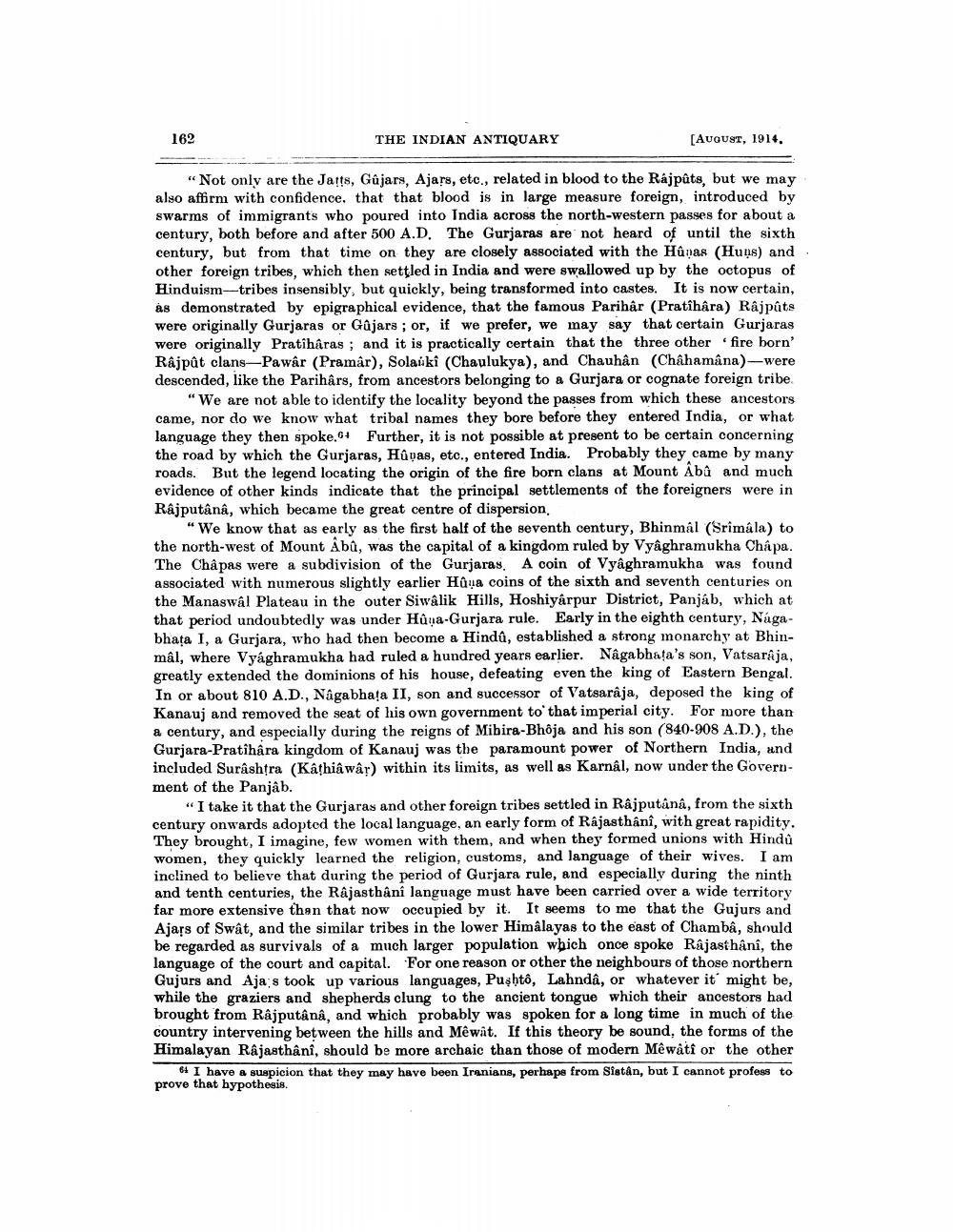________________
162
THE INDIAN ANTIQUARY
[AUGUST, 1914,
"Not only are the Jatts, Gujars, Ajars, etc., related in blood to the Rajpûts, but we may also affirm with confidence. that that blood is in large measure foreign, introduced by swarms of immigrants who poured into India across the north-western passes for about a century, both before and after 500 A.D. The Gurjaras are not heard of until the sixth century, but from that time on they are closely associated with the Hûnas (Huns) and other foreign tribes, which then settled in India and were swallowed up by the octopus of Hinduism-tribes insensibly, but quickly, being transformed into castes. It is now certain, ås demonstrated by epigraphical evidence, that the famous Parihar (Pratîhêra) Rajputs were originally Gurjaras or Gujars; or, if we prefer, we may say that certain Gurjaras were originally Pratihậras ; and it is practically certain that the three other fire born' Râjpût clans—Pawâr (Pramar), Solaiki (Chaulukya), and Chauhân (Chåhamâna)-were descended, like the Parihârs, from ancestors belonging to a Gurjara or cognate foreign tribe
"We are not able to identify the locality beyond the passes from which these ancestors came, nor do we know what tribal names they bore before they entered India, or what language they then spoke. Further, it is not possible at present to be certain concerning the road by which the Gurjaras, Hûvas, etc., entered India. Probably they came by many roads. But the legend locating the origin of the fire born clans at Mount Abû and much evidence of other kinds indicate that the principal settlements of the foreigners were in Rajputânâ, which became the great centre of dispersion
"We know that as early as the first half of the seventh century, Bhinmal (Srimala) to the north-west of Mount Abu, was the capital of a kingdom ruled by Vyâghramukha Chapa. The Châpas were a subdivision of the Gurjaras. A coin of Vyâghramukha was found associated with numerous slightly earlier Hûya coins of the sixth and seventh centuries on the Manaswâl Plateau in the outer Siwâlik Hills, Hoshiyarpur District, Panjab, which at that period undoubtedly was under Hûya-Gurjara rule. Early in the eighth century, Nágabhata I, a Gurjara, who had then become a Hindu, established a strong monarchy at Bhinmâl, where Vyághramukha had ruled a hundred years earlier. Nagabhata's son, Vatsaraja, greatly extended the dominions of his house, defeating even the king of Eastern Bengal. In or about 810 A.D., Nagabhata II, son and successor of Vatsarâja, deposed the king of Kanauj and removed the seat of his own government to that imperial city. For more than a century, and especially during the reigns of Mibira-Bhôja and his son (840-908 A.D.), the Gurjara-Pratihâra kingdom of Kanauj was the paramount power of Northern India, and included Surashtra (Kathiâwâr) within its limits, as well as Karnal, now under the Government of the Panjab.
“I take it that the Gurjaras and other foreign tribes settled in Rajputânâ, from the sixth century onwards adopted the local language, an early form of Rajasthânî, with great rapidity. They brought, I imagine, few women with them, and when they formed unions with Hindu women, they quickly learned the religion, customs, and language of their wives. I am inclined to believe that during the period of Gurjara rule, and especially during the ninth and tenth centuries, the Rajasthani language must have been carried over a wide territory far more extensive then that now occupied by it. It seems to me that the Gujurs and Ajars of Swât, and the similar tribes in the lower Himalayas to the east of Chamba, should be regarded as survivals of a much larger population which once spoke Rajasthânî, the language of the court and capital. For one reason or other the neighbours of those northern Gujurs and Aja s took up various languages, Puşhtô, Lahndâ, or whatever it might be, while the graziers and shepherds clung to the ancient tongue which their ancestors had brought from Rajputânâ, and which probably was spoken for a long time in much of the country intervening between the hills and Mêwat. If this theory be sound, the forms of the Himalayan Rajasthânî, should be more archaic than those of modern Mêwâtî or the other
81 I have a suspicion that they may have been Iranians, perhaps from Sistân, but I cannot profess to prove that hypothesis.




